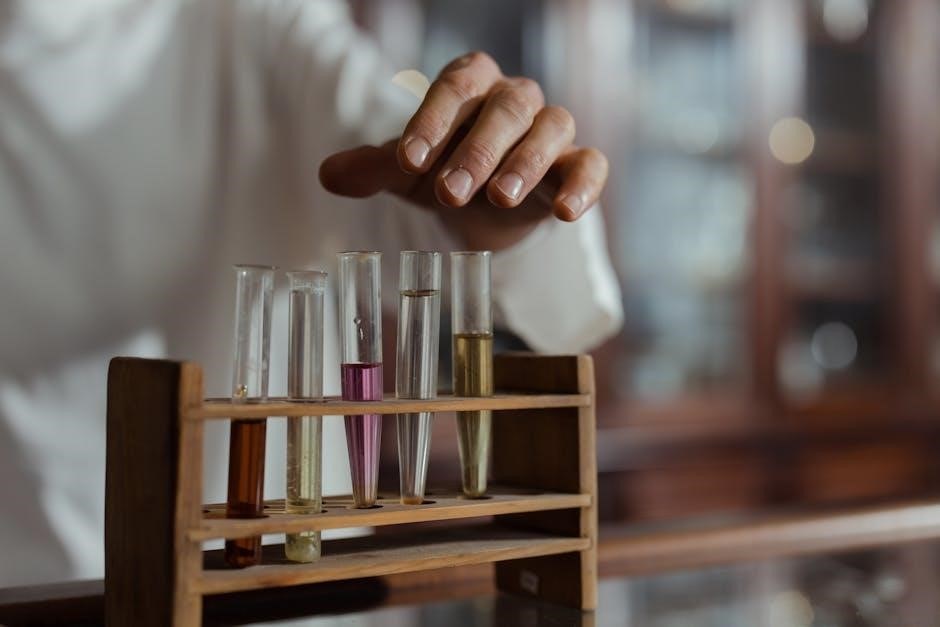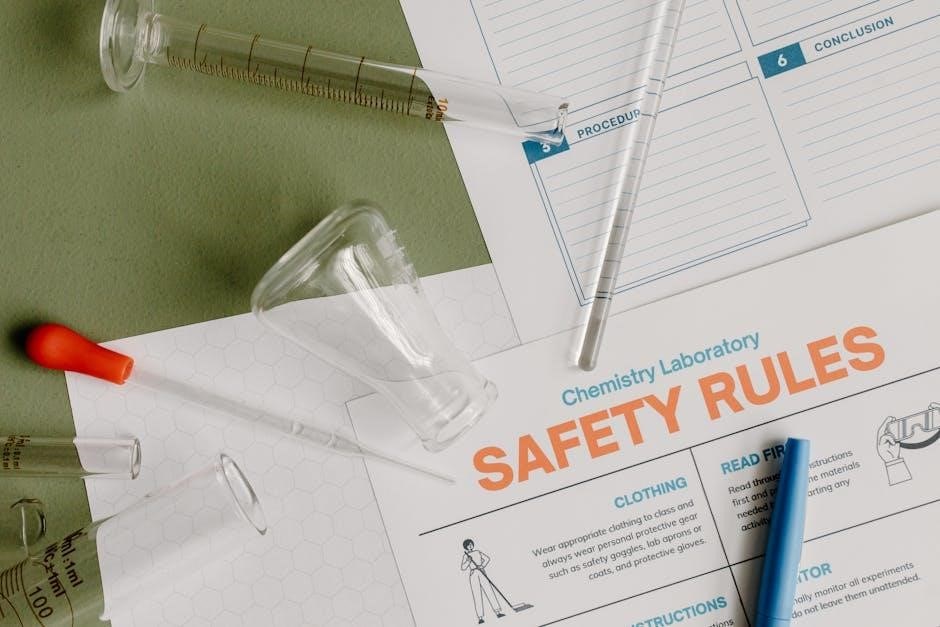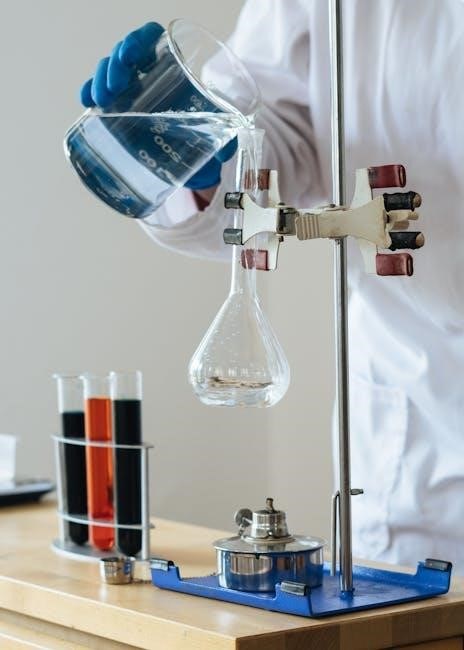final exam study guide chemistry

Master the building blocks of matter, from atoms and molecules to chemical reactions and properties. Explore lab safety and essential concepts for a strong foundation.
1.1; Key Concepts and Terminology
Understanding chemistry basics begins with key concepts like matter, elements, and compounds. Matter is anything with mass and occupies space, while elements are pure substances with unique properties. Compounds are formed by combining elements. Key terms include atomic structure, chemical reactions, and properties (physical and chemical). The periodic table organizes elements by atomic number and properties. Grasp these fundamentals to build a strong foundation for advanced topics and excel in your final exam.
1.2. Importance of Chemistry in Everyday Life
Chemistry is a fundamental science shaping our daily lives. It explains the composition of matter, how substances interact, and the changes they undergo. From household products to advanced medical treatments, chemistry plays a vital role. Understanding chemistry helps us appreciate food production, pharmaceuticals, and environmental conservation. It also drives technological advancements in industries like energy, agriculture, and manufacturing. Studying chemistry fosters problem-solving skills and critical thinking, essential for addressing global challenges. By mastering these concepts, students can better understand the world around them and contribute to its improvement.
1.3. Branches of Chemistry
Chemistry is divided into several branches, each focusing on specific aspects of matter and its transformations. Organic chemistry studies carbon-based compounds, essential for understanding life and materials. Inorganic chemistry explores non-carbon compounds, including acids, bases, and salts. Physical chemistry examines the physical properties and processes of substances, linking chemistry to physics. Analytical chemistry involves methods for identifying and quantifying substances, crucial in quality control and forensic science. Biochemistry investigates chemical processes in living organisms, bridging chemistry and biology. Each branch provides unique insights, enabling advancements in fields like medicine, technology, and environmental science.

The Periodic Table
The periodic table organizes elements by atomic structure, revealing periodic trends. Created by Dmitri Mendeleev, it arranges elements in rows (periods) and columns (groups), aiding predictions of properties and behavior.
2.1. Structure and Organization
The periodic table is structured in rows (periods) and columns (groups), reflecting elements’ atomic structure. Periods represent electron shell filling, while groups share similar properties due to the same valence electrons. Elements are ordered by atomic number, increasing left to right and top to bottom. The table is divided into blocks (s, p, d, f) based on orbital filling. Metals dominate the left, non-metals the right, and metalloids lie in between. This systematic arrangement allows for the identification of trends and relationships among elements, making it a fundamental tool for predicting chemical behavior and understanding periodicity.
2.2. Periodic Trends and Patterns
Periodic trends describe how element properties change systematically across the periodic table. Atomic radius decreases across a period (left to right) and increases down a group. Ionization energy generally increases right and up, though noble gases are exceptions. Electronegativity follows a similar trend, peaking at fluorine. Metallic character decreases from left to right and bottom to top. These patterns arise from periodic variations in atomic structure, such as nuclear charge and electron configuration. Understanding these trends helps predict chemical behavior, reactivity, and bonding tendencies, making them crucial for analyzing and forecasting how elements interact in chemical reactions and compounds.
2.3. Elements and Their Symbols
Elements are represented by unique symbols, often derived from their English or Latin names. For example, carbon is “C,” oxygen is “O,” and gold is “Au” (from Latin aurum). Some symbols, like “Pb” for lead (from plumbum), reflect historical roots. Each symbol is standardized by the International Union of Pure and Applied Chemistry (IUPAC) to ensure global consistency. Knowing these symbols is essential for writing chemical formulas, equations, and communicating effectively in chemistry. Students should memorize key symbols and understand their origins to master chemical nomenclature and solve problems accurately. This foundational knowledge is critical for success in chemistry studies and exams.
2.4. Classification of Elements
Elements are classified into groups and periods on the periodic table based on their atomic structure and properties. Groups (vertical columns) share similar chemical behaviors, such as the reactive alkali metals in Group 1 and noble gases in Group 18. Periods (horizontal rows) reflect increasing atomic number and electron shells. Elements are also categorized as metals, non-metals, or metalloids. Metals are typically shiny, malleable, and good conductors, while non-metals are brittle and poor conductors. Metalloids exhibit intermediate properties. Understanding this classification helps predict chemical behavior and interactions, making it a vital skill for chemistry exams and problem-solving.

Chemical Bonding
Chemical bonding involves the formation of chemical bonds between atoms, such as ionic and covalent bonds. It explains how atoms share or transfer electrons to form compounds, driving reactions and determining properties like stability and reactivity.
3.1. Types of Bonds: Ionic and Covalent
Chemical bonds are forces of attraction between atoms. Ionic bonds form when electrons are transferred between atoms, creating ions held together by electrostatic forces. Covalent bonds involve sharing electrons between atoms, forming molecules. Ionic compounds, like salts, typically form between metals and non-metals, while covalent bonds occur between non-metals. Understanding the differences is key to predicting chemical behavior, solubility, and conductivity. Ionic compounds often conduct electricity in solution, while covalent compounds do not. Examples include NaCl (ionic) and H₂O, CO₂, or CH₄ (covalent).
3.2. Lewis Structures and Electron Configuration
Lewis structures visualize molecular bonding by representing valence electrons. To draw them, count valence electrons, place the central atom, and arrange electrons to satisfy the octet rule. Lone pairs are placed before bonding pairs; Electron configuration follows the Aufbau, Pauli exclusion, and Hund’s rules, filling orbitals from lowest to highest energy. For molecules, valence electrons are shared to form bonds. Lewis structures help predict molecular geometry and bond polarity, while electron configuration explains atomic behavior and periodic trends. Both concepts are essential for understanding chemical bonding and reactivity in molecules and compounds.
3.3. Intermolecular Forces
Intermolecular forces are attractions between molecules, influencing physical properties like boiling and melting points. Key types include hydrogen bonding (strongest), dipole-dipole interactions, and London dispersion forces (weakest). Hydrogen bonding occurs when hydrogenatoms bond with highly electronegative atoms like O, N, or F. Dipole-dipole forces arise from polar molecule interactions, while London forces are temporary and present in all molecules. These forces determine solubility, viscosity, and volatility. Stronger forces lead to higher boiling points and greater viscosity. Understanding these interactions is crucial for predicting substance behavior and phase changes, making them fundamental in chemistry and material science applications.

Stoichiometry
Stoichiometry involves quantitative relationships in chemical reactions, focusing on mole ratios, balanced equations, and calculations of reactant and product amounts, essential for chemical analysis and synthesis.
4.1. Mole Concept and Calculations
The mole is a fundamental unit in chemistry, defined as 6.022 × 10²³ particles (Avogadro’s number). Mole calculations involve converting between moles, grams, and particles using molar mass. Key skills include calculating molar masses from atomic weights, determining moles of substances in reactions, and solving problems involving molarity (concentration). Accurate mole-to-mole and mass-to-mass conversions are critical for stoichiometry. Practice calculations ensure mastery of these essential quantitative skills, which are vital for predicting reaction outcomes and scaling experiments in real-world chemistry scenarios.
4.2. Empirical and Molecular Formulas
Empirical formulas represent the simplest whole-number ratio of atoms in a compound, while molecular formulas show the actual number of atoms. To determine empirical formulas, calculate the moles of each element using their masses and molar masses, then divide by the smallest mole value to find the ratio. Molecular formulas are derived from empirical formulas by multiplying by a factor if necessary; Key steps include converting mass to moles, finding ratios, and simplifying. Practice problems, such as finding the formula of CO₂ (C:O = 1:2), build proficiency in distinguishing and calculating these formulas for various compounds.
4.3. Chemical Equations and Reactions
Chemical equations represent chemical reactions, showing reactants, products, and the conservation of mass. Balancing equations ensures the number of atoms of each element is equal on both sides; Coefficients, not subscripts, are adjusted to balance. Types of reactions include synthesis, decomposition, single-replacement, and combustion. Catalysts speed up reactions without being consumed. Understanding reaction conditions, such as heat or light, is crucial. Practice identifying reaction types and balancing complex equations to master this topic. Accurate stoichiometric calculations rely on balanced equations, making this skill essential for solving reaction problems in chemistry.

Thermodynamics
Thermodynamics studies energy transformations, focusing on heat, work, and energy transfer. It explores system equilibrium, energy conservation, and entropy changes, fundamental to understanding chemical processes and their feasibility.
5.1. Laws of Thermodynamics
The laws of thermodynamics govern energy interactions in physical and chemical systems. The zeroth law introduces temperature and thermal equilibrium. The first law states energy is conserved and can be transformed but not created or destroyed. The second law explains entropy, a measure of disorder, and the direction of spontaneous processes. The third law relates to absolute zero, where entropy approaches a minimum value. These laws are foundational for understanding energy transfer, system equilibrium, and the feasibility of chemical reactions. Mastery of these principles is crucial for analyzing thermodynamic processes and their applications in chemistry.
5.2. Enthalpy, Entropy, and Gibbs Free Energy
Enthalpy (H) represents the total energy of a system, including internal energy and pressure-volume work. Changes in enthalpy (ΔH) indicate energy absorbed or released during a reaction. Entropy (S) measures disorder or randomness, with ΔS reflecting changes in disorder. Gibbs Free Energy (G) determines a reaction’s spontaneity, calculated as ΔG = ΔH ౼ TΔS. A negative ΔG indicates a spontaneous process, while a positive ΔG suggests non-spontaneity. These concepts are essential for predicting reaction feasibility, direction, and energy changes, making them critical tools in thermodynamic analysis and chemical systems.
5.3. Applications in Chemistry
Thermodynamics has numerous practical applications in chemistry, influencing fields like phase changes, chemical equilibrium, and energy systems. It predicts the spontaneity of reactions using Gibbs free energy, aiding in the design of industrial processes. Enthalpy changes guide calorimetry experiments, while entropy helps explain solubility and mixing processes. Thermodynamics also underpins battery efficiency, fuel combustion, and refrigeration cycles. In biochemistry, it explains enzyme reactions and metabolic pathways. Environmental applications include understanding climate change and optimizing energy storage solutions. Mastery of these principles is crucial for solving real-world chemical problems and advancing technological innovations.

Chemical Reactions and Kinetics
Chemical reactions involve transformations of substances, while kinetics studies reaction rates and mechanisms. Understanding these concepts helps predict reaction outcomes and optimize processes in chemistry.
6.1; Types of Chemical Reactions
Chemical reactions are classified into several types based on their characteristics. Synthesis reactions involve combining substances to form a new compound, while decomposition reactions break down compounds into simpler substances. Single replacement reactions involve one element displacing another, and double replacement reactions swap ions between compounds. Combustion reactions involve substances reacting with oxygen, often releasing heat and light. Acid-base reactions produce salts and water, and gas-evolution reactions release gases. Recognizing these types helps predict products and balance equations, essential for understanding chemical processes and their applications in various fields.
6.2. Reaction Rates and Catalysts
Reaction rate refers to the speed at which reactants are converted into products. It is influenced by factors like concentration, temperature, surface area, and catalysts. Catalysts are substances that speed up reactions without being consumed. They lower the activation energy, making reactions occur faster. Inhibitors, conversely, slow down reactions. Understanding reaction rates and catalysts is crucial for controlling chemical processes. Catalysts are widely used in industrial applications to optimize efficiency and reduce costs. They play a vital role in enzymes, batteries, and pollution control, highlighting their importance in both biological and industrial chemistry.
6.3. Activation Energy and Reaction Mechanisms
Activation energy is the minimum energy required for a reaction to occur. It determines the rate and feasibility of a reaction. Reaction mechanisms describe the step-by-step processes by which reactants are transformed into products. They often involve intermediate steps and transition states. Understanding activation energy and mechanisms helps predict reaction outcomes and optimize conditions. High activation energy reactions are slower, while low energy ones are faster. Catalysts can lower activation energy, but the mechanism remains unchanged. Studying these concepts is essential for analyzing chemical kinetics and thermodynamics.

Acids, Bases, and pH
Acids donate H+ ions, while bases accept them. The pH scale measures acidity/basicity, ranging from 0 (strong acid) to 14 (strong base), with 7 being neutral.
7.1. Definitions and Properties
Acids are substances that donate H⁺ ions, while bases accept H⁺ ions. Acids have a sour taste, turn litmus red, and react with bases to form salts. Bases feel slippery, turn litmus blue, and neutralize acids. The pH scale measures acidity/basicity, with 0-6.99 being acidic, 7 neutral, and 7.01-14 basic. Strong acids (e.g., HCl) fully dissociate in water, while weak acids (e.g., CH₃COOH) partially dissociate. Similarly, strong bases (e.g., NaOH) fully dissociate, and weak bases (e.g., NH₃) partially dissociate. Understanding these properties is key to solving acid-base problems and calculating pH levels.
7.2. Strong and Weak Acids/Bases
Strong acids, like HCl and HNO₃, fully dissociate in water, releasing H⁺ ions completely. Weak acids, such as CH₃COOH, partially dissociate, releasing fewer H⁺ ions. Similarly, strong bases (e.g., NaOH, KOH) fully dissolve, releasing OH⁻ ions, while weak bases (e.g., NH₃) partially dissolve. The strength of an acid or base determines its conductivity in solution. Strong acids/bases are strong electrolytes, while weak ones are weak electrolytes. Understanding this distinction is crucial for predicting chemical behavior and calculating concentrations in solutions. This concept is fundamental for acid-base chemistry and equilibrium calculations.
7.3. pH Calculation and Buffer Solutions
The pH of a solution is calculated using the formula pH = -log[H⁺], where [H⁺] is the hydrogen ion concentration. For strong acids/bases, [H⁺] or [OH⁻] can be directly determined. For weak acids/bases, dissociation constants (Ka or Kb) are used. Buffer solutions, made from weak acids/bases and their conjugates, resist pH changes. The Henderson-Hasselbalch equation, pH = pKa + log([A⁻]/[HA]), is key for buffer calculations. Understanding pH and buffers is essential for laboratory work and real-world applications, such as maintaining biological systems or controlling chemical reactions.

Lab Equipment and Safety
Familiarize yourself with common laboratory equipment such as beakers, test tubes, Bunsen burners, and pipettes. Understand safety protocols like wearing goggles, gloves, and lab coats, and using fume hoods.
8.1. Common Laboratory Tools
Key laboratory tools include beakers, test tubes, Erlenmeyer flasks, and volumetric flasks for measuring and holding liquids. Bunsen burners and heating mantles are used for heating substances; Graduated cylinders and pipettes ensure precise measurements. Lab balances measure mass, while crucibles and tongs handle hot samples. Glassware like funnels and condensers aid in experiments. Familiarize yourself with these tools and their functions to enhance lab efficiency and safety.
8.2. Safety Protocols and Precautions
Essential safety protocols include wearing personal protective equipment (PPE) like lab coats, goggles, gloves, and closed-toe shoes. Familiarize yourself with emergency exits, fire extinguishers, and eyewash stations. Handle chemicals carefully, reading labels and using fume hoods for volatile substances. Avoid ingesting or touching hazardous materials. Tie back long hair and avoid loose jewelry. Follow proper procedures for heating and mixing substances. Dispose of waste correctly and decontaminate equipment. Always adhere to instructions and avoid horseplay. Lab safety ensures a secure environment for everyone.

Nuclear Chemistry
Nuclear chemistry studies changes in atomic nuclei, including fission, fusion, and radioactive decay. It explores energy production, medical applications, and environmental impacts of nuclear processes.
9.1. Radioactivity and Nuclear Reactions
Radioactivity involves the emission of radiation from unstable nuclei to achieve stability. Key types include alpha, beta, and gamma radiation. Nuclear reactions, such as fission (e.g., uranium-235 splitting) and fusion (e.g., hydrogen isotopes combining), release vast energy. These processes are fundamental to nuclear power and weaponry. Understanding reaction types, half-life, and decay constants is crucial. Applications include energy production, medical treatments, and dating ancient materials. Safety and environmental impacts, like radiation exposure and waste disposal, are critical considerations in nuclear chemistry studies. Mastering these concepts is essential for understanding modern technological and environmental challenges.
9.2. Applications in Medicine and Industry
Nuclear chemistry has transformative applications in medicine and industry. In medicine, radioisotopes like iodine-131 are used for cancer treatment and diagnostics. PET scans rely on positron-emitting isotopes to image tissues. Industrially, nuclear energy powers millions of homes via fission reactors. Radioisotopes also sterilize medical tools and food, ensuring safety. In materials science, neutron bombardment creates stronger alloys. Radiation detects pipeline leaks and measures material thickness. These applications highlight nuclear chemistry’s role in advancing healthcare, energy, and manufacturing, while emphasizing the need for responsible use and safety protocols to minimize risks.

Environmental Chemistry
Environmental chemistry studies the chemical processes impacting Earth’s environment, addressing air and water pollution, and the effects of chemicals on ecosystems and human health.
10.1. Pollution and Its Impact
Pollution refers to the introduction of harmful substances into the environment, contaminating air, water, and soil. Key sources include industrial emissions, agricultural runoff, and improper waste disposal. Air pollution contributes to climate change and respiratory diseases, while water pollution disrupts aquatic ecosystems and affects human health. Soil pollution impacts agricultural productivity and food safety. Understanding pollution’s environmental and health effects is crucial for developing sustainable solutions to mitigate its impact and promote ecological balance.
10.2. Green Chemistry and Sustainability
Green chemistry focuses on designing processes and products to minimize environmental impact. It emphasizes reducing waste, using renewable resources, and avoiding toxic substances. Key principles include atom economy, safer solvents, and energy efficiency. Sustainability ensures resources are used responsibly, meeting current needs without compromising future generations. Green chemistry supports eco-friendly technologies, such as biodegradable materials and clean energy solutions. By integrating sustainability, chemists develop innovative approaches to reduce pollution and promote a healthier planet, aligning with global environmental goals and fostering long-term ecological balance.
Exam Preparation Tips
- Understand key concepts and formulas thoroughly.
- Solve practice problems regularly to build confidence.
- Review class notes and textbook summaries.
- Use flashcards for important terminology.
- Get enough rest and maintain a study schedule.
11.1. Study Strategies and Time Management
Effective study strategies involve active recall, spaced repetition, and breaking material into manageable chunks. Begin by identifying key topics and allocating time proportionally. Use flashcards for quick reviews and create concept maps to visualize relationships. Prioritize problem-solving to apply theoretical knowledge. Schedule regular breaks using techniques like Pomodoro (50 minutes study, 10 minutes break). Maintain a consistent study routine and avoid cramming. Review mistakes to improve understanding. Set specific daily goals and track progress. Stay organized with a planner or digital tool to balance tasks efficiently. Regular practice and timely revision are essential for long-term retention and exam success.
11.2. Practicing Past Papers and Mock Exams
Practicing past papers and mock exams is crucial for exam success. Start by solving past papers to familiarize yourself with the exam format, question types, and time allocation. Mock exams simulate real test conditions, helping you manage stress and improve pacing. Review your answers to identify weak areas and focus on improving them. Use model answers to compare and refine your responses. Timing yourself ensures adherence to exam duration, enhancing your ability to complete all questions. Regular practice builds confidence and reduces anxiety, allowing you to approach the final exam with clarity and precision. Consistency is key to mastering exam techniques.